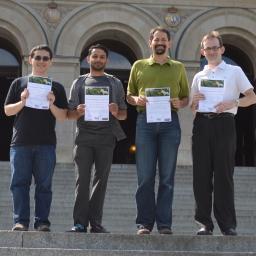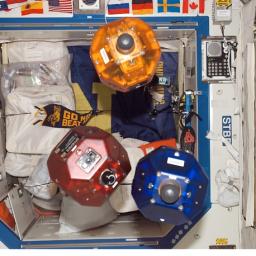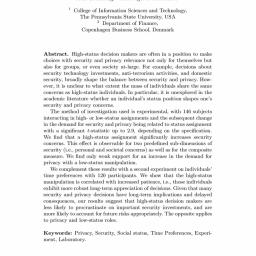
Most programming languages come with built in support for handling common data types, however using and manipulating user-defined data types has to be done via general purpose syntax. This often leads to using Strings rather than structured data. Computer scientists have
designed safe way to use multiple programming languages within the same program, which will allow programmers to use the language most suitable for each function while also guarding against code injection. Their language, called Wyvern, is
available as an Open Source Project.
The full paper is
available as a PDF.
Wyvern determines which sublanguage is being used within the program based on the type of data the programmer is manipulating. Types specify the format of data, such as alphanumeric characters, floating-point numbers or more complex data structures, such as Web pages and database queries.
...
Many programming tasks can involve multiple languages; when building a Web page, for instance, HTML might be used to create the bulk of the page, but the programmer might also include SQL to access databases and JavaScript to allow for user interaction. By using type-specific languages, Wyvern can simplify that task for the programmer, Aldrich said, while also avoiding workarounds that can introduce security vulnerabilities.
 Researchers have found
Researchers have found (
Abstract) that the more gruesome a description of a crime is, the more the person hearing the description thinks the perpetrator should be punished. However, if the act was unintentional, the description did not change the severity judged as fair.
When the responses were analyzed, the researchers found that the manner in which the harmful consequences of an action are described significantly influences the level of punishment that people consider appropriate: When the harm was described in a graphic or lurid fashion then people set the punishment level higher than when it was described matter-of-factly. However, this higher punishment level only applied when the participants considered the resulting harm to be intentional. When they considered it to be unintentional, the way it was described didn't have any effect.
Recent scientific inquiry shows that the mighty Tyrannosaurus may have been inclined to hunt in packs, rather than going it alone. Adjacent track ways of tyrannosaurus footprints have been discovered (
full text) that suggest that tyrannosaurids hunted in packs. The fossilised footprints show clear evidence that the animals
travelled together, with all three tracks going in the same direction around the same time, suggesting that these dinosaurs may have been social, and not solitary, animals.
The skeletal record of tyrannosaurids is well-documented, whereas their footprint record is surprisingly sparse. There are only a few isolated footprints attributed to tyrannosaurids and, hitherto, no reported trackways. We report the world's first trackways attributable to tyrannosaurids, and describe a new ichnotaxon attributable to tyrannosaurids. These trackways are from the Upper Cretaceous (Campanian - Maastrichtian) of northeastern British Columbia, Canada. One trackway consists of three tridactyl footprints, and two adjacent trackways consist of two footprints each. All three trackways show animals bearing southeast within an 8.5 meter-wide corridor. Similarities in depth and preservation of the tyrannosaurid tracks indicate that these three trackways were made by track-makers walking concurrently in the same direction. These trackways add significantly to previous osteology-based hypotheses of locomotion and behavior in Tyrannosauridae by providing ichnologic support for gregariousness in tyrannosaurids, and the first record of the walking gait of tyrannosaurids.

The conditions deep inside large planets, such as Jupiter, Uranus and other planets recently discovered outside our solar system, have been
experimentally recreated. This allows researchers to re-create and accurately measure material properties that control how these planets evolve over time (information that is essential for understanding how these massive objects form).
Using the largest laser in the world, the National Ignition Facility at Lawrence Livermore National Laboratory, teams from the Laboratory, University of California, Berkeley and Princeton University squeezed samples to 50 million times Earth's atmospheric pressure, which is comparable to the pressures at the center of Jupiter and Saturn. Of the 192 lasers at NIF, the team used 176 with exquisitely shaped energy versus time to produce a pressure wave that compressed the material for a short period of time. The sample -- diamond -- is vaporized in less than 10 billionths of a second.
Though diamond is the least compressible material known, the researchers were able to compress it to an unprecedented density greater than lead at ambient conditions.
"The experimental techniques developed here provide a new capability to experimentally reproduce pressure-temperature conditions deep in planetary interiors," said Ray Smith, LLNL physicist and lead author of the paper. Such pressures have been reached before, but only with shock waves that also create high temperatures -- hundreds of thousands of degrees or more -- that are not realistic for planetary interiors. The technical challenge was keeping temperatures low enough to be relevant to planets. The problem is similar to moving a plow slowly enough to push sand forward without building it up in height. This was accomplished by carefully tuning the rate at which the laser intensity changes with time.
"This new ability to explore matter at atomic scale pressures, where extrapolations of earlier shock and static data become unreliable, provides new constraints for dense matter theories and planet evolution models," said Rip Collins, another Lawrence Livermore physicist on the team.
AbstractA study on plants using data from over 1000 forests has found that
the size and age of the plant has more of an impact on their productivity than temperature and precipitation.
"A fundamental assumption of our models for understanding how climate influences the functioning of ecosystems is that temperature and precipitation directly influence how fast plants can take up and use carbon dioxide," said Enquist, a professor in the UA's Department of Ecology and Evolutionary Biology whose research lab led the study.
"Essentially, warm and wet environments are thought to allow plant metabolism to run fast, while cold and drier environments slow down metabolism and hence lower biomass production in ecosystems," he said. "This assumption makes sense, as we know from countless experiments that temperature and water control how fast plants can grow. However, when applied to a the scale of entire ecosystems, this assumption appears to not be correct."
To test the assumption on the scale of ecosystems, the team developed a new mathematical theory that assesses the relative importance of several hypothesized drivers of net primary productivity. That theory was then evaluated using a massive new dataset assembled from more than 1,000 different forest locations across the world.
The analysis revealed a new and general mathematical relationship that governs worldwide variation in terrestrial ecosystem net primary productivity. The team found that plant size and plant age control most of the variation in plant productivity, not temperature and precipitation as traditionally thought.
The abstract is available here.
Since 2006, three bowling ball-size free-flying Synchronized Position Hold, Engage, Reorient, Experimental Satellites (SPHERES) have been floating around the International Space Station. Now, they are
attaching a smartphone to the spheres, making them "Smart SPHERES", a more "intelligent" free-flying robot with built-in cameras to take pictures and video, sensors to help conduct inspections, powerful computing units to make calculations and Wi-Fi connections to transfer data in real time to the computers aboard the space station and at mission control in Houston.
In a two-phase experiment, astronauts will manually use the smartphones to collect visual data using the integrated custom 3-D sensor to generate a full 3-D model of their environment. After the map and its coordinate system are developed, a second activity will involve the smartphones attached to the SPHERES, becoming the free-flying Smart SPHERES. As the free-flying robots move around the space station from waypoint to waypoint, utilizing the 3-D map, they will provide situational awareness to crewmembers inside the station and flight controllers in mission control. These experiments allow NASA to test vision-based navigation in a very small mobile product.
"NASA uses robots for research and mission operations; just think about the rovers on Mars or the robotic arm on the ISS or space shuttle," said Chris Provencher, manager of the Smart SPHERES project. "Inside the ISS space is limited, so it's really exciting to see technology has advanced enough for us to demonstrate the use of small, mobile robots to enhance future exploration missions."
Ultimately it is the hope of researchers that these devices will perform housekeeping-type tasks, such as video surveys for safety and configuration audits, noise level measurements, air flow measurements, and air quality measurements, that will offset work the astronauts currently perform.
It seems popular opinion is relatively settled that breathing second-hand smoke is unhealthy, and that non-smokers who are exposed to it are at risk of illness. But the scientific evidence keeps piling up to support that theory, and even to extend the risks to another level: Third-hand Smoke!
Research into "third hand" smoke (residual tobacco smoke gases and particles that are deposited to surfaces and dust) has highlighted the potential cancer risk in non-smokers of non-dietary ingestion and dermal exposure to carcinogen N-nitrosamines and tobacco-specific nitrosamines (TSNAs) [
Abstract].
Using a highly sensitive and selective analytical approach we have determined the presence of nicotine, eight N-nitrosamines and five tobacco-specific nitrosamines in forty-six settled dust samples from homes occupied by both smokers and non-smokers. Using observations of house dust composition, we have estimated the cancer risk by applying the most recent official toxicological information. Calculated cancer risks through exposure to the observed levels of TSNAs at an early life stage (1 to 6 years old) exceeded the upper-bound risk recommended by the USEPA in 77% of smokers' and 64% of non-smokers' homes.
[Ed. note: apparently, not only should you not stand next to someone smoking, but you shouldn't even walk through a place where someone has smoked, ever. Cancel my next trip to Paris, please.]

New research
(abstract) suggests that those in higher-level positions are
more likely to make decisions that value security over privacy, and be more determined to carry out those decisions. In one experiment, people who were appointed supervisors showed a significant increase in their concern for security. The researchers also found that participants who were assigned a worker-level status expressed higher concern for privacy, but not significantly higher.
We find that a high-status assignment significantly increases security concerns. This effect is observable for two predefined sub-dimensions of security (i.e., personal and societal concerns) as well as for the composite measure. We find only weak support for an increase in the demand for privacy with a low-status manipulation.
[Ed. note: that would explain why your boss is always more conservative/risk averse than you'd like. Maybe the perks and salary are too good to give up, so he'll do anything to stay where he is? In which case: let's pay them less.]

Columbia University researchers
have just published a study into the effectiveness of mobile adverts and come to some conclusions that may bode well for people who worry their smartphones will someday be yet another vector for annoying marketing. Turns out, adverts for many products are ineffective on mobile devices.
MDA campaigns that ran between 2007 and 2010 and involved 39,946 consumers show that MDA campaigns significantly increased consumers' favorable attitudes and purchase intentions only when the campaigns advertised products that were higher (vs. lower) involvement and utilitarian (vs. hedonic).
They are most effective when a product is either practical or are something that takes thought and investigation before making a purchase. Furthermore:
- Mobile ads do work for products that have a practical and important use, like a lawn mower or a washing machine
- Mobile ads do work for high-involvement products (a lot of time, thought and energy is placed into the decision, like a family car).
- Mobile ads don't work for just-for-pleasure items, like fancy watches
- Mobile ads don't work for low-involvement purchases like movie tickets or toothbrush (ones that pose a low risk to the buyer)
The study's abstract is available here.

A
phase-changing material could be used in low-cost robots to allow them to switch between hard and soft states. The material is made from a flexible open-cell foam coated in wax that can achieve significant ranges of stiffness, strength, and volume [
Abstract].
The material - developed by Anette Hosoi, a professor of mechanical engineering and applied mathematics at MIT, and her former graduate student Nadia Cheng, alongside researchers at the Max Planck Institute for Dynamics and Self-Organization and Stony Brook University - could be used to build deformable surgical robots. The robots could move through the body to reach a particular point without damaging any of the organs or vessels along the way.
Robots built from the material, which is described in a new paper in the journal Macromolecular Materials and Engineering, could also be used in search-and-rescue operations to squeeze through rubble looking for survivors, Hosoi says.
To build a material capable of shifting between squishy and rigid states, the researchers coated a foam structure in wax. They chose foam because it can be squeezed into a small fraction of its normal size, but once released will bounce back to its original shape.
The wax coating, meanwhile, can change from a hard outer shell to a soft, pliable surface with moderate heating. This could be done by running a wire along each of the coated foam struts and then applying a current to heat up and melt the surrounding wax. Turning off the current again would allow the material to cool down and return to its rigid state.
In addition to switching the material to its soft state, heating the wax in this way would also repair any damage sustained, Hosoi says. "This material is self-healing," she says. "So if you push it too far and fracture the coating, you can heat it and then cool it, and the structure returns to its original configuration."
 Most programming languages come with built in support for handling common data types, however using and manipulating user-defined data types has to be done via general purpose syntax. This often leads to using Strings rather than structured data. Computer scientists have designed safe way to use multiple programming languages within the same program, which will allow programmers to use the language most suitable for each function while also guarding against code injection. Their language, called Wyvern, is available as an Open Source Project.
Most programming languages come with built in support for handling common data types, however using and manipulating user-defined data types has to be done via general purpose syntax. This often leads to using Strings rather than structured data. Computer scientists have designed safe way to use multiple programming languages within the same program, which will allow programmers to use the language most suitable for each function while also guarding against code injection. Their language, called Wyvern, is available as an Open Source Project.




